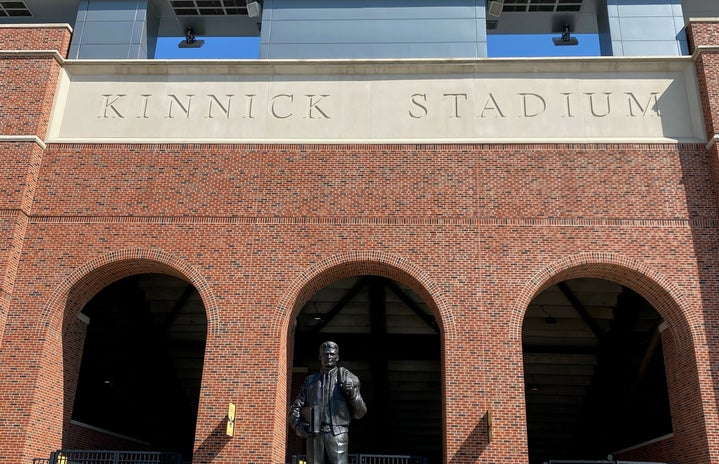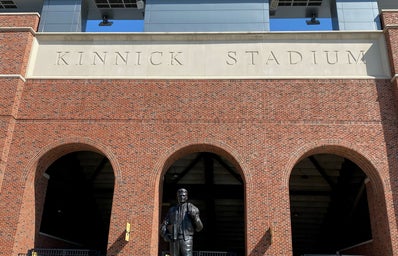Hercules awaits her time to shine in the pressbox at University of Iowa’s Kinnick Stadium. A crowd of 70,000 is about to be awed yet again by her grace as she soars to the field just before kickoff at home football games. She hones in on her reward located on the field. With a signal from her trainer, she takes off, gliding just feet over the heads of cheering fans. Hercules has been practicing for this moment with the Iowa Raptor Project to start a new tradition for Hawkeye fans. But what this incredible raptor doesn’t know is that she’s a symbol for something much larger than a football game tradition.
Hercules is a red-tailed hawk that lives at the Iowa Raptor Project located in Solon, Iowa, just 11 miles north of Kinnick Stadium in Iowa City. Red-tailed hawks are easy to train, making Hercules the preferred choice for the flying entrance at Kinnick Stadium. Hercules’ name is coined from the University of Iowa mascot, “Herky,” which is short for Hercules the Hawk.
Hercules is an unreleasable raptor that has to be kept in captivity. She and 16 other birds of prey have been rescued and cared for long-term at the Iowa Raptor Project. The Iowa Raptor Project aims to connect students and communities to the conservation of birds of prey through research and educational opportunities. Partnering with the University of Iowa and Kirkwood Community College has allowed the Iowa Raptor Project to expand its limits and provide educational opportunities to a larger audience, including having Hercules fly at Hawkeye football games.
Dave Conrads, the director of the University of Iowa’s College of Education’s UI Wild, has loved birds of prey since his work with the Iowa DNR-funded hawk migration study in the fall of 1987 on the Mississippi River. “I’ve been active in raptor research and now, primarily, in conservation education. So anything we can do to help promote the conservation of Iowa’s raptors and their habitats captures my interest,” said Conrads. Since then, he’s been committed to conservation education with UI Wild with programs like School of the Wild and Iowa Wildlife Camps, and now enjoys spreading awareness with Hercules’ appearance at University of Iowa football games.
When Conrads was hired as the director of the Iowa Raptor Project in 1990, fans were already asking when a hawk would fly at Kinnick Stadium. “It’s been in the air – so to speak – for quite a while,” said Conrads. “The Air Force Academy has been training and flying falcons since 1956, so the precedent had already been set. When Athletics approached us about partnering to establish the Raptor Ambassador Program a few years ago, we began discussing how that might work.”
Hercules is a staple for birds of prey in the state of Iowa by flying at the Iowa Hawkeye’s football games. “We believe it’s a tremendous opportunity to bring our conservation message to a larger audience. Our ultimate goal is to awaken awareness, nurture appreciation, and inspire action for all things wild, including Iowa’s birds of prey and their natural habitats,” said Conrads. But does Hercules feel the love or does the large, rowdy crowd bring the red-tailed hawk stress?
Even though Hercules is used to being around people at the Raptor Center, she still has the chance of feeling stressed during her flight in Kinnick Stadium. Hercules is closely monitored before her flight to ensure the safety of herself, trainers, and fans at the game. Oversight from the United States Fish and Wildlife Service, the Iowa Department of Natural Resources, and the Institutional Animal Care and Use Committee of the University of Iowa ensure that Hercules is kept safe at all times both in preparation for and during her flight to the field.
It’s thought that raptors experience greater stress in larger crowds. This anthropomorphism, the attribution of human-like characteristics to animals, is false. Hercules has the same risk of feeling stress in both a small group of people compared to a much larger and louder group. Master falconers, Ryan and Holly Anthony, both work with the Iowa Raptor Project to help ensure the holistic health of Hercules. “They can tell if a bird is stressed, content, or maybe in between… If a bird would show signs of stress, whether in a large crowd or a small one, we would remove that bird from the situation. It’s the right thing to do,” said Conrads.
Conrads and other Iowa Raptor Project employees plan to expand Hercules’ conservation message to other Hawkeye sporting events at Carver-Hawkeye Arena. This would include men’s basketball, women’s basketball, men’s wrestling, and women’s gymnastics. Although Hercules won’t fly at these events, the message will be voiced to many. Expanding the Iowa Raptor Project’s audience will garner more attention to raptor conservation and ensure a positive future for the Iowa Raptor Project, Hercules, and the 16 other raptors at the Iowa Raptor Center.
“Our conservation education efforts help people make better decisions on environmental policy and day-to-day life, thereby protecting our wild resources and natural ecosystems,” said Conrads. Hercules is a symbol for all of the other raptors at the Iowa Raptor Project, as well as a staple for the conservation of raptors in the state of Iowa. “Our small collection of live raptors serve as ambassadors to the much larger wild raptor population by teaching thousands of diverse Iowans about conservation every year,” said Conrads. As the Iowa Fight Song goes, “Fight for Iowa,” Hercules does this by fighting for Iowa’s raptor conservation and education outreach. Or, you could even call it a “Flight for Iowa.”


